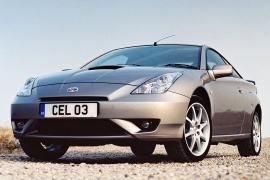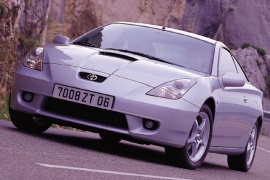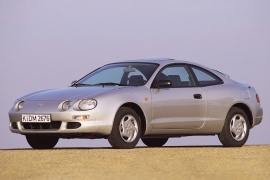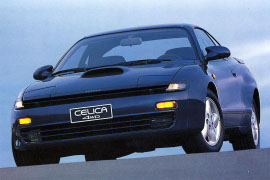TOYOTA Celica Models/Series Timeline, Specifications & Photos
First production year: 1990
Engines: Gasoline
Body style: Coupé (two-door)
Toyota updated the seventh generation of the Celica in 2002 when it performed a few visual upgrades for the already appealing coupe.
Most sports cars from that era were either unreliable or had to make some concessions for family reasons. There were a few exceptions from that, and the Celica was one of them. It didn't just look sharp, but the automaker didn't make a compromise just to attract more customers. Toyota tried to offer a coupe focused on the driver. The only thing that was lacking in that generation, when compared to its predecessors, was the all-wheel drive system.
From the outside, the Celica showed a restyled front fascia, which received a new bumper and a slim air intake. In addition, the hood was modified to fit the new upgrades while the headlights got new lenses. Moreover, on the sides, the front fenders, the door panels, and the rear quarter panels sported an ascending sculptured line that visually connected the front wheel-wells to the rear ones. Finally, at the back, the taillights received a smoked look, and the blinkers didn't sport amber lenses anymore but red.
Inside, there was the same interior, with a three-spoke steering wheel and an instrument cluster where analog dials and an LCD shared the same area. Yet, the carmaker claimed that there were some improvements that made the car more focused on the driver. It still featured four seats, with a 50/50 split-folding rear bench where only children could sit.
Under the hood, Toyota made good use of its two 1.8-liter powerplants offered in lower or higher power output. Both versions were mated with a six-speed manual gearbox. For specific markets, the carmaker included a four-speed automatic to the options list.
In January 1999, Toyota unveiled an exciting-looking coupe named XYR at the Detroit Motor Show, and soon after, it launched the production version of it, the seventh generation of the Celica.
The Celica nameplate began its journey back in 1970 as a coupe and a three-door hatchback based on the same platform as the Toyota Carina. Over the next generations, the sporty coupe became a sensation in motorsports, both in the World Rally Championship and in the IMSA. Famous drivers, such as Bjorn Waldegard, Carlos Sainz, Dan Gurney, and Robert Huffman, drove the car to the highest places on the podiums. With such a great racing record, Toyota introduced the seventh generation of this nameplate on the market in 1999 for the 2000 model year.
Designed at Toyota's CALTY Design Centre in Newport Beach, California, the seventh generation of the Celica surprises everyone due to its aggressive front fascia that dropped the rounded shapes of the sixth generation. Its triangular, swept-back headlights and the carmaker's badge placed inside a small-sized scoop on the bumper looked unusual. In addition, the upper air intake tried to create the image of a sports car. Last but not least, the lower bumper featured an apron where the main cooling area was placed and was flanked by a set of side scoops for the available fog lamps.
From its profile, the sporty-looking Celica revealed a set of creases and sharp lines that emphasized the curved lines of the roofline and waistline. The raked windshield was followed by a short roof and a very long, sloped-down tailgate. While the designers looked very inspired when they made the car's front and profile, it looked like they lost their inspiration when they had to pen the rear end. Two small-sized taillights flanked the wide tailgate, and a tall bumper completed the aspect of the rear fascia.
Inside, Toyota created an attractive-looking dashboard fitted with a small-sized but logical instrument cluster. The speedometer took center stage and was flanked by the tachometer on the left and by digital gauges on the right. It looked spectacular for those times. Unfortunately, the quality of the materials was not what customers expected from the Celica. But still, they could get the car with a set of leather-wrapped sports seats that could sweeten the deal. In the back, the bench seat profiled for two offered just enough room for carrying children back and forth on short trips, but the headroom was limited for adult-sized occupants.
But the most disappointing part of the Celica's seventh generation was found under its skin. Unlike its previous two generations, it wasn't available with an all-wheel drive or a turbocharged version. Toyota offered the car with a choice of two engines with the same 1.8-liter displacement that provided less than 200 ponies in the highest version. For the lower-powered version, the Celica was available with either a five-speed manual or a four-speed automatic, while the top-spec version was offered with a six-speed manual only.
It was one of the best sport-compact coupe vehicles from its era, with huge success due to its World Rally Championship titles. The street version though was a different story.
The Toyota Celica was offered with three bodywork styles: hatchback-coupe, three-box coupe, and convertible. The hatchback-coupe version was the base model for the rally-car, with a turbocharged engine and all-wheel-drive. The Europeans received it, but they didn't get it with the convertible and the three-box coupe version. The U.S. version was available with all three bodyworks.
When compared with its predecessor, which featured pop-up headlights, the 1994 Celica featured four rounded headlights and no grille. The engine was cooled via the front-integrated wide grille. The side fluid lines were typical for the biodesign era when the car was designed.
Inside, there were four seats installed, but the rear room was very limited. The interior featured a driver-oriented dashboard and high-bolstered front seats. The car was fitted with dual airbags for the front occupants, but the ABS was optional for the base model. The air-conditioning was fitted as standard on the GT trim levels.
The base engine was increased over its predecessor from a 1.6-liter to a 1.8-liter, while the top version was the 2.2-liter unit. In Europe, a 2.0-liter naturally aspirated and a 2.0-liter turbocharged was offered, the later being mated to an all-wheel-drive system. The U.S. models were stripped of that and the Celica was offered with front-wheel-drive only. A wider track and a stiffer suspension over its predecessor made the 1994 Celica better on the corners.
The 1990 Toyota Celica will remain in history as one of the most successful rally-cars ever made, with over 30 WRC wins and world titles for the team or its drivers.
In the mid-'90s, Toyota struggled to beat the other carmakers in the World Rally Championship, but the Lancia and Ford teams were faster. The Japanese carmaker knew that without an all-wheel-drive version will lose the game, and then, in 1989, it introduced the Celica lineup with the GT4 as the most potent version. Then, everything changed, and it became the car to beat.
The 1990 Celica switched from its predecessor's angled design to the rounded shapes of the biodesign era. Its pop-up headlights were still en-vogue, and the curved, short cabin was designed to minimize drag resistance. Toyota offered the car either as a hatchback or as a coupe. The GT4 was available only as a hatchback and sported an air-intake and a few extra vents on the hood.
Inside, the carmaker installed four seats, but there was very limited room in the back, even for a toddler. In many countries, a 2-seat car was taxed more than if it had four. Toyota installed a rounded instrument cluster with the minimum information required. Only the GT4 version featured an oil temperature gauge.
Toyota offered the Celica with a choice of engines ranged between 103 hp and 200 hp. Only the latter was fitted with an all-wheel-drive system.



